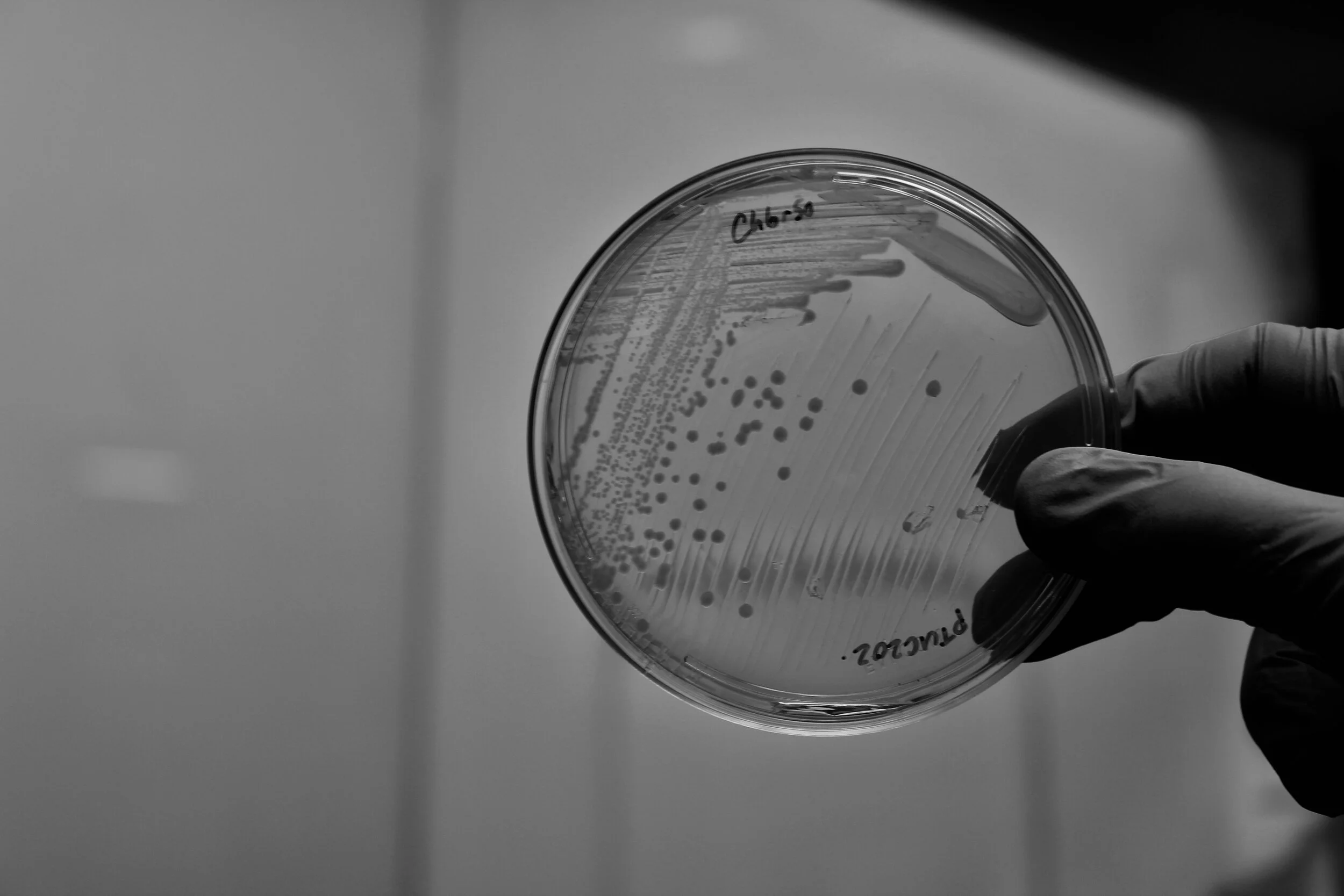Synthetic Biology
We are employing engineering principles to model, design and build synthetic gene circuits and programmable cells, in order to create novel classes of diagnostics & therapeutics. We are also using deep learning approaches to discover new genetic parts and enhance the synthetic biology design process.
Antibiotics & AI
As part of the Antibiotics-AI Project, we are harnessing the power of artificial intelligence (AI) to discover novel classes of antibiotics and rapidly understand how they work. We are also using deep learning approaches for the de novo design of new antibiotics and the development of combination treatments.
The Collins Lab is part of the Institute for Medical Engineering and Science (IMES) and the Department of Biological Engineering at MIT, the Harvard-MIT Program in Health Sciences and Technology (HST), the Broad Institute of MIT and Harvard, and the Wyss Institute for Biologically Inspired Engineering at Harvard. At MIT, our lab is part of the Synthetic Biology Center, the Computational and Systems Biology Initiative, and the Microbiology Graduate Program.
RECENT PUBLICATIONS
Active learning framework leveraging transcriptomics identifies modulators of disease phenotypes
Benjamin DeMeo, Charlotte Nesbitt, Samuel A. Miller, Daniel B. Burkhardt, Inna Lipchina, Doris Fu, Peter Holderreith, David Kim, Sergey Kolchenko, Artur Szalata, Ishan Gupta, Christine Kerr, Thomas Pfefer, Raziel Rojas-Rodriguez, Sunil Kuppassani, Laurens Kruidenier, Parul B. Doshi, Mahdi Zamanighomi, James J. Collins, Alex K. Shalek, Fabian J. Theis, Mauricio Cortes
Science (2025)
Phenotypic drug screening remains constrained by the vastness of chemical space and technical challenges scaling experimental workflows. To overcome these barriers, computational methods have been developed to prioritize compounds, but they rely on either single-task models lacking generalizability or heuristic-based genomic proxies that resist optimization. We designed an active deep-learning framework that leverages omics to enable scalable, optimizable identification of compounds that induce complex phenotypes. Our generalizable algorithm outperformed state-of-the-art models on classical recall, translating to a 13-17x increase in phenotypic hit-rate across two hematological discovery campaigns. Combining this algorithm with a lab-in-the-loop signature refinement step, we achieved an additional two-fold increase in hit-rate and molecular insights. In sum, our framework enables efficient phenotypic hit identification campaigns, with broad potential to accelerate drug discovery.
Convergence of nanotechnology and CRISPR-based diagnostics
Midori Johnston, Schan Dissanayake-Perera, James J. Collins, Molly M. Stevens, and Can Dincer
Nature Nanotechnology (2025)
In addition to its broad application in genome engineering and therapeutics, clustered regularly interspaced short palindromic repeats (CRISPR) technology provides field-deployable methods for the highly sensitive and selective detection of nucleic acids. From a diagnostic perspective, CRISPR-based assays hold clear clinical potential for identifying a range of both infectious and non-communicable diseases. In this Perspective we evaluate recent nanotechnologies and nanomaterials that have been engineered to interface with CRISPR systems on a nanoscale level to realize the full potential of this versatile diagnostic tool. We assess biomolecules such as enzymes and oligonucleotides, some of the more commonly used synthetic nanoparticles and detection platforms that integrate nanotechnologies in new and innovative ways. We discuss current trends and look ahead to future challenges and opportunities, including non-nucleic acid target detection, pre-amplification-free detection of nucleic acids, the development of wearable devices and integration with artificial intelligence workflows.
A generative deep learning approach to de novo antibiotic design
Aarti Krishnan, Melis N. Anahtar, Jacqueline A. Valeri, Wengong Jin, Nina M. Donghia, Leif Sieben, Andreas Luttens, Yu Zhang, Seyed Majed Modaresi, Andrew Hennes, Jenna Fromer, Parijat Bandyopadhyay, Jonathan C. Chen, Danyal Rehman, Ronak Desai, Paige Edwards, Ryan S. Lach, Marie-Stephanie Aschtgen, Margaux Gaborieau, Massimiliano Gaetani, Samantha G. Palace, Satotaka Omori, Lutete Khonde, Yurii S. Moroz, Bruce Blough, Chunyang Jin, Edmund Loh, Yonatan H. Grad, Amir Ata Saei, Connor W. Coley, Felix Wong, and James J. Collins
Cell (2025)
The antimicrobial resistance crisis necessitates structurally distinct antibiotics. While deep learning approaches can identify antibacterial compounds from existing libraries, structural novelty remains limited. Here, we developed a generative artificial intelligence framework for designing de novo antibiotics through two approaches: a fragment-based method to comprehensively screen >10^7 chemical fragments in silico against Neisseria gonorrhoeae or Staphylococcus aureus, subsequently expanding promising fragments, and an unconstrained de novo compound generation, each using genetic algorithms and variational autoencoders. Of 24 synthesized compounds, seven demonstrated selective antibacterial activity. Two lead compounds exhibited bactericidal efficacy against multidrug-resistant isolates with distinct mechanisms of action and reduced bacterial burden in vivo in mouse models of N. gonorrhoeae vaginal infection and methicillin-resistant S. aureus skin infection. We further validated structural analogs for both compound classes as antibacterial. Our approach enables the generative deep-learning-guided design of de novo antibiotics, providing a platform for mapping uncharted regions of chemical space.
Using Machine Learning for Antibiotic Discovery
Cesar de la Fuente-Nunez and James J. Collins
Physical Review Letters (2025)
Antimicrobial resistance is a critical global health challenge and one of the World Health Organization’s top ten public health threats. The alarming rise of drug-resistant pathogens threatens to usher in a postantibiotic era where common infections could once again become fatal. Despite the urgency, traditional discovery methods are time-consuming, expensive, and insufficient to keep pace with rapidly evolving resistance. Recent advances in machine learning (ML) and artificial intelligence (AI) present a transformative alternative, enabling the rapid identification of potential candidate antibiotics in a fraction of the time required by conventional methods. In this Essay, we discuss how ML and AI significantly accelerate antibiotic discovery, drawing on previous works and insights in this emerging field. We also consider the promises and challenges of this emerging area and speculate on its evolution in the coming years, highlighting the potential contributions from the physics community.
Optogenetics-enabled discovery of Integrated stress response modulators
Felix Wong, Alicia Li, Satotaka Omori, Ryan S. Lach, Jose Nunez, Yunke Ren, Sean P. Brown, Vipul Singhal, Brent R. Lyda, Taivan Batjargal, Ethan Dickson, Jose Roberto Rodrigues Reyes, Juan Manual Uruena Vargas, Shalaka Wahane, Hahn Kim, James J. Collins and Maxwell Z. Wilson
Cell (2025)
The integrated stress response (ISR) is a conserved stress response that maintains homeostasis in eukaryotic cells. Modulating the ISR holds therapeutic potential for diseases including viral infection, cancer, and neurodegeneration, but few known compounds can do so without toxicity. Here, we present an optogenetic platform for the discovery of compounds that selectively modulate the ISR. Optogenetic clustering of PKR induces ISR-mediated cell death, enabling the high-throughput screening of 370,830 compounds. We identify compounds that potentiate cell death without cytotoxicity across diverse cell types and stressors. Mechanistic studies reveal that these compounds upregulate activating transcription factor 4 (ATF4), sensitizing cells to stress and apoptosis, and identify GCN2 as a molecular target. Additionally, these compounds exhibit antiviral activity, and one compound reduced viral titers in a mouse model of herpesvirus infection. Structure activity and toxicology studies highlight opportunities to optimize therapeutic efficacy. This work demonstrates an optogenetic approach to drug discovery and introduces ISR potentiators with therapeutic potential.







